growing
Orchids
outside & unprotected in the UK
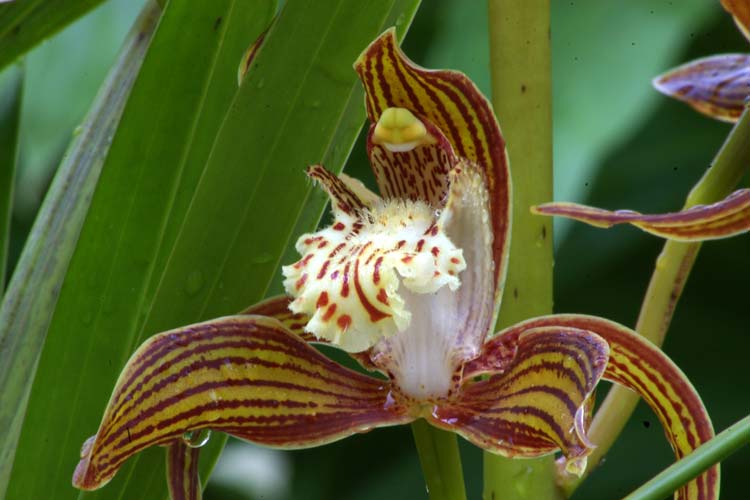 |
| A close-up of a Cymbidium tracyanum flower. This orchid used to be popular as a house plant before it was ousted by Phalaenopsis which is now the flavour of the month. Cymbidiums are, in my view, far more attractive plants when and if, and this is a very big if, they flower. Phalaenopsis does not have any such problems and can be coaxed into flowering during much of the year. While Cymbidium species and hybrids can successfully be grown in the open (in the South-West of the U. K. at least), Phalaenopsis is invariably wiped out during any season apart from summer and is not a plant to even try in the garden other than on the compost heap. |
General
Orchids have a reputation for being difficult and success with them was once regarded as the ultimate test of a competent gardener. Yet those who grow them claim they no more demanding than other plants - just that they sometimes have to be treated differently. At this stage I am still a relative beginner with orchids, but judging by general experience, I imagine that many things are easy if you have the appropriate knowledge, the facilities and are fluent in the techniques. Orchids can certainly be grown by an averagely competent gardener but I would hesitate in calling them easy - although there are a few species which can be literally shoved into a hole in the garden and then almost forgotten about. The difficulty probably stems mainly from the lack of detailed cultural information regarding this intriguing family of plants. This is now gradually being addressed as the popularity of orchids increases. Furthermore, many of them have been difficult to obtain as well as being expensive making experimentation a somewhat risky business.
All orchid seeds require very special conditions if they are to germinate; moreover, seedlings take many years to reach maturity. Commercial growers are able to use this and micro-propagation to produce vast numbers of young plants. This is not a the gardner would take preferring to propagate orchids vegetatively by dividing their pseudobulbs in the same way as the splitting of any other groups of bulbs, corms or tubers. This method gives much smaller numbers of plants but has the virtue of producing good-sized specimens. The key here is to know when to dig up and divide so as not to create setbacks or even destruction of the plants.
Hardy Orchids
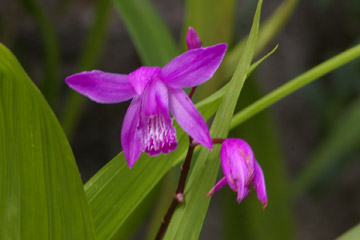 |
| Bletilla striata is both attractive and easy: easy to find and easy to grow. |
It will hardly come as a surprise to discover that not all orchids are attractive or worth growing. This is a general observation applying to plants of all families and genera. There is one orchid, Bletilla striata from China, which is both strikingly attractive and remarkably easy to grow. Depending on variety the colours range from white, through pink to a deep purple. There is a variegated variety but I have found it to be far less vigorous than the green-leaved type. Bletilla striata takes a few degrees of frost in its stride, grows well both in sun and semi-shade and seems happy in most garden soils provided they contain organic matter and are not waterlogged. It is best planted (or re-planted) soon after flowering. In a friend's garden a very large clump has grown for many years on a dry and hot sunny bank.
Bletilla striata is thus an undemanding plant which gives 'full value for money' and can be left undisturbed (other than occasional high potash feeding to encourage good flowering) for many years. Often available in garden centres it can literally be shoved into a hole in the ground and treated as any other rhizomatous perennial. A decent-sized clump will eventually develop but it may take a few years.
The European genus Dactylorhiza (Marsh Orchids) has several available species which are fully hardy and easy to grow. Most prefer an alkaline soil. Jeff Hutchings of the Hardy Orchid Nursery in Lancashire mentions that Dactylorhiza fuchsii, the Common Spotted Marsh Orchid, often seeds itself into gardeners' forgotten pots of soil and make its presence known only when it first flowers! At Southern Comfort we have had D. maculata (the Spotted Heath Orchid) growing for some three years. Its spread, however, has been less than impressive and we need to lift and reposition it where it will have more light. At Ray Brown's Nursery, Plant World in Newton Abbot, both D. maculata and D. foliosa (syn. maderensis) grow successfully on the dryish, sunny banks surrounding the plant sales area. D. maculata, which has attractively mottled foliage, prefers acid soil.
Epipactis is another reputedly easy genus of which we are trying out Epipactis gigantea (the Stream Orchid from North America) in a damp patch of soil at the end of the rill. In the wild, it grows in similarly damp conditions. Other hardy or near hardy orchids which are probably worth a try are Calanthe (many species available but not all hardy) and Pleione formosana.
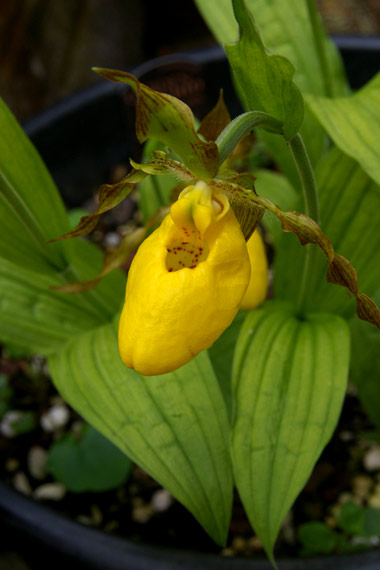 |
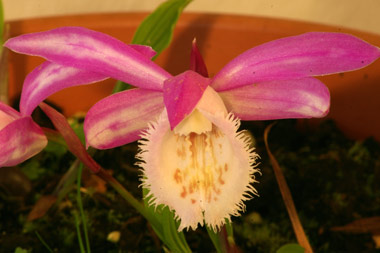 |
Top: Pleione formosana 'Oriental Splendour'. This Pleione species is reputedly the hardiest and is grown in a similar way to the cypripedium. These are small plants - under 10 cm tall and are probably best grown in pots in order to prevent them being swamped by surrounding plants. They can be divided and re-potted in the spring before the pseudobulbs begin to produce roots and shoots.
Cypripedium 'Pueblo' . This is most likely the North American species C. parviflorum pubescens according to Jeff Hutchings of Laneside Hardy Orchids. This plant has overwintered in a pot with no special protection and grows in a mixture of pumice, bark chippings with a little moss peat and garden compost. Cypripediums can also be planted out or plunged in both plastic and terracotta pots. Although somewhat exacting in their requirements they are all fully hardy in the U.K.. Their roots must always be kept cool and never allowed to dry out. The plants should be divided only towards the end of the dormant period in early spring. |
Cypripedium
This is perhaps the most famous orchid genus - that of the Slipper Orchids. The only British native, Cypripedium calceolus (the Lady's Slipper Orchid) almost became extinct here in recent years as a result of over-collecting (a habit dating back hundreds of years) but is now in the process of making a comeback. We do not have this species at Southern Comfort although it is available from nurserymen and dealers. However, there are many other Cypripedium species (North American and Asiatic) and some, including C. calceolus and various hybrids, have been intensively propagated by commercial nurseries. Most, with some notable exceptions, prefer a pH on the higher side of 7 and are hardy provided the soil conditions are optimal.
Two related North American species caught my eye because they are similar to the British and European native. They are Cypripedium parviflorum and Cypripedium pubescens. I have obtained what may be a hybrid of the two or possibly C. pubescens itself. The plant was marketed under the name of Cypripedium 'Pueblo'. The flowers were captivating to observe and the plant, repotted into a mixture of loam and pumice, survived the winter with no protection against damp or cold and began to produce buds at the beginning of March eventually doubling in size by June.
Another one to try is C. reginae, also form North America. This plant has reddish pouches and comes highly recommended by Jeff Hutchings (who also supplies it).
Cymbidium
Most orchid growers express surprise whenever I mention that I have cymbidiums growing outside all year round. "Too risky", "They're tender", "'Come off it", "Sooner or later you'll lose 'em all"' are amongst the more optimistic answers. There may be something in this but in the meantime they have given me much fun and pleasure. I would not wish to be without them. In fact, I consider them to be ideal plants to experiment with but only in a mild climate.
I have grown cymbidiums outside for some years, both in pots and in the ground. In fact, I have never tried them indoors - even for 10 minutes. Flowering is sporadic and unpredictable; fortunately, with the number of plants I have I am seldom disappointed. Although in the wild this genus is epiphytic it adapts well to growing in a pot or in the ground provided it is provided with a very well-drained acidic medium with bark chippings and the like. Because cymbidiums are large plants they do not dry out easily (which they must not be allowed to do1) and the medium (whether in a pot or in the ground) requires only occasional watering. I generally give a high potash feed from
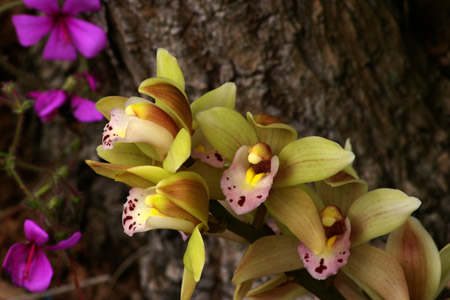 |
| This Cymbidium hybrid has been growing outside in the vicinity of a Cordyline australis for some eight years. Provided that winter temperatures do not drop below minus 4°C we can expect it to continue to grow and flower for years to come. |
The most robust and hardy of the genus are reputed to be Cymbidium tracyanum and C. georingii. Cymbidium tracyanum is, in my view, also one of the most attractive with purple and green striped petals and a generally chunky feel to the whole plant. Cymbidium hybrids seem to possess varying degrees of hardiness as well as varying degrees of appeal. I have acquired many at the end of their flowering season when garden centres try to unload weary-looking unsellable plants at knock-down prices. They always recover quickly and within a few months look none the worse for wear.
Dendrobium
Some years ago I obtained some dendrobium cuttings from a cousin in Poland. He obtained the original plant at a market stall somewhere in Warsaw. While I have no idea as to its identity I discovered that plant is remakably resisitent to life outdoors. It has not always been at its best at the end of winter but it proved to be a more or less reliable flowerer. My cousin grew it in pots in ordinary garden soil keeping it outside during the warm summers and overwintering it indoors. I have not had any inclination to try it in the soil outside but have been strongly tempted to try growing it as an epiphyte. More about this later.
In an effort to check whether other dendrobiums are similarly 'hardy' I occasionally purchased the odd dendrobium whenever I saw it being offered with a discount. Sadly, I lost them all. During this period my stock of the Polish dendrobium has been very gradually increasing to the extent that I am now confident that this particular plant can be left outside without any special precautions.
Orchids as epiphytes
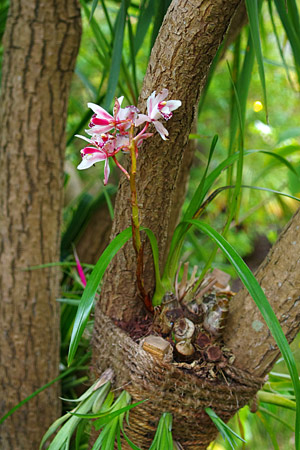 |
| This small Cymbidium hybrid flowered soon after being placed in an 'epiphytic' environment on a Cordyline australis. Wind damage soon made the blooms unsightly. Other plants growing out of the sides of the basket are Billbergia nutans. |
As far as I am aware there are no fully hardy epiphytic orchids. Currently, I am experimenting with providing outdoor 'epiphytic' conditions for cymbidiums and dendrobiums in an area where the former have proved to be hardy over a period of years. With the flower spikes of cymbidiums naturally growing out at all angles a position on a tree is ideal for displaying both the natural habit of the plant and the blooms themselves at eye level or thereabouts.
So far my experience has been limited to overwintering a cymbidium hybrid on a Cordyline australis at a height of about 1 m. The container or basket was woven out of natural rope and two oak braces were used to enlarge the volume of the crotch.This sort of basket will be more durable than the ones (made out of phormium leaves) which I have generally used so far. It is also more robust. Despite this high-tech build it still blends in to be almost not noticeable. Small Billbergia nutans offsets were poked into the sides partly to give the orchid some company and enhance the composition but mainly for the billbergia roots to bind in the orchid roots which are not themselves adhesive and therefore would not give the plant adequate purchase when the basket eventually desintergates ( three years is probably a good lifespan for such a basket). Time will tell whether this arrangement makes sense. The total volume of the basket is probably around 2 litres. Unless
A small cymbidium hybrid which had never before flowered was planted in a mixture of mainly orchid bark (with some ericaceous compost added) in mid-summer 2017. Somewhat surprisingly a flower stem began to appear during the winter and the plant flowered in April 2016. It is too early to count this as success but it is certainly an indication of what can be achieved with a bit of inventiveness. However, there was one disappointing side. The position of the plant above ground exposed it to a greater degreee of wind damage than it would have been subject to at ground level with the result that the flowers soon became battered out of all recognition. Obviously, the answer is to place such a plant in a very shelted position.
Growing cymbidium in this way nevertheless requires more attention to be paid to watering. A occasional spraying with the hose or watering from a can during drier periods as well as an occasional high potash feed is probably enough; in my experience Cymbidium (like other epiphytes) is relatively resistant to drought.
1. This is
often stressed in books and articles. Whilst I do not doubt the wisdom
of not allowing cymbidiums to dry out I suspect that they may be fairly
resistent to drought conditions on account of their robust pseudobulbs.
Over the years I have had many cymbidiums growing outside in pots; they
were not always regularly watered, especially during the summer months,
but I have never had any losses on damage as a result.
2. Many problems associated with growing cymbidiums may be due to inappropriate
growing medium. In the wild cymbidiums are epiphytes and they grow in
débris which collects on and around trees. This material is invariably
neutral to acid and never alkaline. Unless such conditions are met the
plants will be unable to thrive. The orchid potting bark mentioned above
meets this requirement. Care should be taken to ensure that the plants
are watered with neutral to soft water - never using hard or alkaline
water.